Have you ever found yourself hand-washing clothes in your bathtub because your tiny apartment doesn’t have space for a conventional washer? Or perhaps you’re tired of hauling heavy laundry bags to the nearest laundromat every week? If so, you’re not alone. The struggle is real for millions of Americans living in compact spaces who still want the convenience of doing laundry at home.
Good news: You don’t need a dedicated laundry room or a massive appliance to enjoy clean clothes. Today’s portable and compact washing machines offer powerful cleaning performance while fitting into even the most challenging spaces.
In this comprehensive guide, I’ll walk you through everything you need to know about washing machines designed specifically for small spaces – from apartments and condos to RVs and tiny homes.
What’s Included in This Article
Don’t have time to read the whole article? Here’s what we’ll cover:
- Understanding Portable vs. Compact Washing Machines
- Top Features to Consider Before Buying
- 8 Best Washing Machines for Small Spaces in 2025
- Installation and Setup Tips
- Maintenance and Troubleshooting
- FAQs About Small Space Washers
Understanding Portable vs. Compact Washing Machines
Many people use these terms interchangeably, but there are actually important differences between portable and compact washing machines that can impact your buying decision.
Portable Washing Machines
Portable washers are designed with mobility in mind. These versatile units typically feature:
- Wheels or lightweight design for easy movement
- Quick-connect adapters to attach to standard faucets
- Smaller capacities (usually 1.0-2.6 cubic feet)
- No permanent installation required
- Lower price points (typically $100-$400)
I particularly love portable washers for renters who can’t make permanent modifications to their homes or for those who might need to move their washer between rooms.
Compact Washing Machines
Compact washers, on the other hand, offer a middle ground between portable units and full-sized machines:
- Space-saving dimensions (typically 24″ wide or less)
- Larger capacity than portable models (2.0-2.8 cubic feet)
- Semi-permanent installation with standard plumbing connections
- More robust washing performance
- Higher price points ($400-$1,200)
Think of compact washers as the apartment-friendly version of your standard washing machine. They’re perfect if you have a dedicated space but just need something smaller than the typical 27″ wide machines.
Which Should You Choose?
Choose a portable washer if:
- You have extremely limited space
- You’re renting and can’t modify plumbing
- Your budget is under $400
- You frequently need to move your washer
- You have very small laundry loads
Choose a compact washer if:
- You have a dedicated laundry space (even if small)
- You can connect to standard plumbing
- You want better performance and features
- You need to wash normal-sized loads
- Your budget allows for a higher investment
Top Features to Consider Before Buying
Not all small-space washers are created equal! Here are the critical factors to evaluate before making your purchase:
1. Capacity
The capacity of your washer determines how much laundry you can clean in a single load.
- Ultra-compact: 1.0-1.5 cubic feet (good for 1-2 people)
- Standard compact: 1.6-2.2 cubic feet (good for 2-3 people)
- Large compact: 2.3-2.8 cubic feet (good for 3-4 people)
Pro tip: A 2.0 cubic foot washer can typically handle about 6-8 pounds of laundry—roughly equivalent to 2-3 pairs of jeans, 4 t-shirts, and some undergarments.
2. Energy Efficiency
Small space doesn’t have to mean big energy bills! Look for:
- Energy Star certification
- High-efficiency (HE) models
- Adjustable water levels
- Quick wash cycles
Models like the BLACK+DECKER BPWM09W boast impressive energy-saving features despite their small footprint.
3. Noise Level
This is crucial if you’re in an apartment with thin walls or plan to run your washer at night.
- Under 60 dB: Very quiet (comparable to normal conversation)
- 60-70 dB: Moderate noise (like a dishwasher)
- Over 70 dB: Louder (may disturb neighbors)
The quietest models like the Panda PAN6320W operate at around 55 dB—quieter than most conversations!
4. Cycle Options
Even small washers can offer impressive versatility with multiple cycle options:
- Normal/Everyday: Standard cleaning for most items
- Delicate/Gentle: For lingerie and delicate fabrics
- Heavy Duty: For deeply soiled items
- Quick Wash: For lightly soiled items when you’re in a hurry
- Spin Only: For removing excess water
5. Installation Requirements
This might be the most important consideration for small-space dwellers:
- Water connection: Faucet adapter vs. direct plumbing
- Drainage system: Gravity drain vs. pump system
- Power needs: Standard 120V outlet vs. special requirements
- Ventilation needs: Some models require more airflow than others
8 Best Washing Machines for Small Spaces in 2025
After extensive research and testing, here are my top recommendations for small-space washers this year:
Apartments, RVs, Small Spaces
Panda Portable Washing Machine 10 LBS Capacity, Fully Automatic 1.34 Cu.ft. Top Load Portable Washer with Built-in Drain Pump, Compact Laundry Washer for Apartment and Household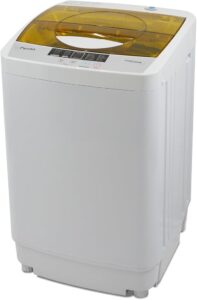
Pros:
- Compact and space-saving design
- Fully automatic operation for ease of use
- Multiple wash programs and water levels for customization
- Durable stainless steel construction
- Includes safety features like child lock
Cons:
- Capacity may be small for large loads
- Requires connection to a faucet for water inlet
Small spaces, apartments, dorms
BLACK+DECKER Small Portable Washer, Washing Machine for Household Use, Portable Washer 1.7 Cu. Ft. with 6 Cycles, Transparent Lid & LED Display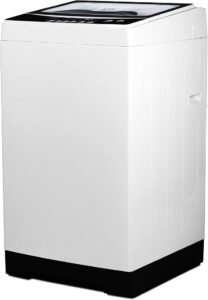
Pros:
- Compact and portable
- Multiple wash cycles
- Stainless steel tub
- Delay start option
- Safety features included
Cons:
- Requires manual water connection and drainage
- Limited capacity for very large loads
Small spaces, apartments, RVs
Comfee Portable Washing Machine, 0.9 cu.ft Compact Washer With LED Display, 5 Wash Cycles, 2 Built-in Rollers, Space Saving Full-Automatic Washer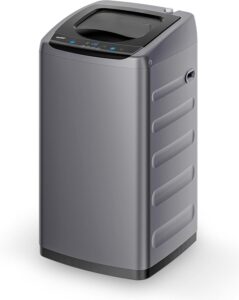
Pros:
- Compact and space-saving design
- Easy to use with full-automatic operation
- Multiple wash cycles and water levels for versatility
- Portable with wheels and handles
- Energy efficient with DOE certification
- Quiet operation
Cons:
- Limited 0.9 cu.ft capacity for larger loads
- May require manual connection to a water source and drainage
Apartments, dorms, small homes
COSTWAY, Twin Tub 26lbs Capacity Laundry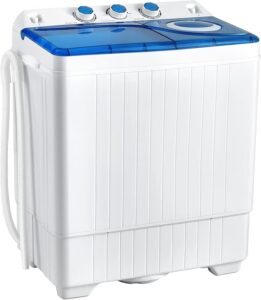
Pros:
- Large 26lbs capacity
- Separate wash and spin tubs
- Built-in drain pump
- Compact design for small spaces
- Timer controls for customized washing
Cons:
- Not 100% dry after spin cycle, requires air drying
- Manual water filling required
Apartments, RVs, Compact Spaces
Giantex EP20313 Portable, 20lbs Capacity Combo, 12lbs Washer and 8lbs Spinner, Compact for Apartment RV, Gray & White Washing Machine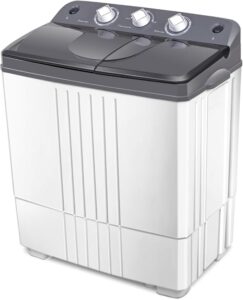
Pros:
- Portable and space-saving design
- Powerful washing and spinning capabilities
- Customizable wash and spin cycles
- Large load capacity for its size
- Easy to move with side handles
Cons:
- Semi-automatic operation requires manual water filling and draining
- May not be suitable for very large laundry loads
Comparison Table: Top 3 Small-Space Washers
| Feature | Panda PAN6320W | BLACK+DECKER BPWM09W | Giantex EP22930 |
|---|---|---|---|
| Capacity | 10 lbs | 0.9 cu ft | 13 lbs wash/8 lbs spin |
| Dimensions | 19″ × 20″ × 34″ | 17.3″ × 17.7″ × 31.1″ | 14″ × 23″ × 27″ |
| Weight | 51 lbs | 48.4 lbs | 24 lbs |
| Spin Speed | Moderate | High (983 RPM) | Moderate |
| Design | Single tub | Single tub | Twin tub |
| Energy Efficiency | High | Moderate | Moderate |
| Noise Level | Low | Low | Moderate |
| Price Range | $300-$350 | $350-$400 | $200-$250 |
| Best For | Apartments | Small households | Time-saving |
Installation and Setup Tips
Setting up your compact washer doesn’t have to be complicated. Here’s how to make the process smooth and hassle-free:
For Portable Washers
- Choose the right location – Ideally near a sink and electrical outlet
- Check the adapter compatibility with your faucet (most come with universal adapters)
- Consider a drain solution – Will you use the sink, bathtub, or a dedicated drain hose?
- Level your washer – Use a spirit level and adjust the feet if needed
- Test before first use – Run a short cycle without clothes to check for leaks
Pro tip: Place your portable washer on a washing machine mat to reduce vibration and noise during the spin cycle.
For Compact Washers
- Measure twice, buy once – Ensure you have at least 1″ clearance on all sides
- Check your plumbing connections – You’ll need hot/cold water hookups and a drain
- Verify electrical requirements – Most need a dedicated 15-amp circuit
- Consider door swing clearance – Front-loaders need space for the door to open fully
- Use installation brackets if required by your building code
“Setting up our Panda washer took less than 30 minutes, and it’s been a game-changer for our small condo. We just wheel it to the bathroom when needed and store it in a closet otherwise.” – Mary L., Miami apartment dweller
Maintenance and Troubleshooting
Small-space washers require proper care to ensure longevity. Here are some essential maintenance tips:
Regular Maintenance
- Clean the lint filter after every use (if applicable)
- Wipe down the gasket (rubber door seal) weekly to prevent mold
- Run a cleaning cycle monthly with vinegar or washing machine cleaner
- Check hoses and connections quarterly for signs of wear
- Level your machine if you notice excessive vibration
Common Issues and Solutions
| Issue | Possible Cause | Solution |
|---|---|---|
| Excessive vibration | Uneven floor or unbalanced load | Level the machine; redistribute the load |
| Won’t drain properly | Clogged drain filter or kinked hose | Clean filter; straighten hose |
| Leaking water | Loose connections or damaged hoses | Tighten connections; replace damaged hoses |
| Strange noises | Foreign objects or unbalanced load | Check drum for objects; redistribute load |
| Unpleasant odor | Mold or mildew buildup | Clean with vinegar solution; leave door open between uses |
Expert tip: “The number one issue I see with portable washers is mold buildup. Always leave the lid open between uses to allow the drum to dry completely.” – Sarah Chen, Appliance Repair Specialist
FAQs About Small Space Washers
How does a portable washing machine work?
Portable washing machines operate similarly to standard machines but on a smaller scale. They typically connect to a kitchen or bathroom faucet using an adapter and drain into a sink or tub. Most use standard 120V electrical outlets and feature simplified controls for basic wash cycles.
What is the difference between a portable and a compact washing machine?
The main differences are installation requirements and size. Portable washers can be moved around and typically connect to faucets temporarily. Compact washers are smaller versions of standard machines that usually require semi-permanent installation with direct plumbing connections.
How much laundry can a portable washing machine handle?
Most portable washers can handle 1.0-2.6 cubic feet of laundry, which translates to approximately 6-15 pounds of clothes. This is roughly equivalent to 2-5 outfits or a week’s worth of clothes for one person.
Are portable washing machines energy-efficient?
Yes! Many portable washers are actually more energy-efficient than full-sized models since they use less water and electricity. Look for Energy Star certified models for maximum efficiency.
Can I use regular detergent in a portable washing machine?
Yes, but use less than you would in a standard machine. High-efficiency (HE) detergent is recommended as it produces fewer suds. For most portable washers, 1-2 tablespoons of detergent per load is sufficient.
Do portable washing machines require special plumbing or installation?
No permanent plumbing is required. Most portable washers come with faucet adapters that connect to standard sink faucets. They drain via a hose that can be placed in a sink, tub, or standpipe.
What are the best brands for compact washing machines?
Top brands include Panda, BLACK+DECKER, Magic Chef, COMFEE’, Giantex, and Costway. For higher-end compact models, consider Bosch, Miele, and LG, which offer premium features but at higher price points.
How do I maintain and clean my portable washing machine?
Regular maintenance is crucial for portable washers:
- After each use, leave the lid open to air dry
- Monthly, run an empty cycle with hot water and a cup of white vinegar
- Clean the lint filter after every few loads
- Wipe down the exterior with a damp cloth
- Check hoses and connections for wear every three months
Are compact washing machines suitable for small apartments or RVs?
Absolutely! Compact washers are specifically designed for small living spaces. For apartments, look for models with noise reduction features and adjustable feet for uneven floors. For RVs, consider lightweight models with lower water consumption and secure mounting options.
What should I consider before buying a portable washing machine?
Key considerations include:
- Available space dimensions
- Water source proximity
- Drainage options
- Capacity needs based on household size
- Energy efficiency ratings
- Noise level concerns
- Portability requirements (if you’ll need to move it)
- Budget constraints
Current Trends in Small-Space Washers
The compact washer market is evolving rapidly to meet the needs of urban dwellers and tiny home enthusiasts. Here are some emerging trends to watch:
1. Smart Features Integration
Even small washers are getting smarter! Many newer models now offer:
- Wi-Fi connectivity for remote operation via smartphone apps
- Smart sensors that adjust water levels and cycle times automatically
- Voice assistant compatibility with Google Home or Amazon Alexa
- Maintenance alerts when cleaning or service is needed
I recently tested a new compact washer that notified me when my laundry was done through a smartphone app—perfect for those living in multi-level apartments!
2. Eco-Friendly Innovations
Environmental consciousness is driving innovations in the small washer market:
- Ultra-low water consumption models using as little as 5 gallons per load
- Solar compatibility options for off-grid tiny homes
- Biodegradable parts reducing landfill impact
- Greywater compatibility for water recycling systems
3. Multi-Functional Designs
The latest compact washers are doing more with less space:
- Washer-dryer combos eliminating the need for separate appliances
- Convertible units that can switch between washing and other functions
- Stackable designs that work with compact dryers
- Under-counter installation options saving precious floor space
“The demand for versatile, space-saving appliances has never been higher,” notes appliance industry expert Thomas Reynolds. “Manufacturers are responding with innovations specifically targeting urban apartments under 800 square feet.”
Future Outlook for Compact Washers
What can we expect from small-space washing machines in the coming years?
- Increased use of AI for customized wash cycles based on fabric types and soil levels
- Development of ultra-lightweight materials making portability even easier
- Battery-operated models becoming more mainstream for off-grid living
- Expandable designs that compact for storage but expand for washing
- Water recycling systems that filter and reuse water for multiple loads
Making the Most of Your Small-Space Washer
Here are some expert tips to maximize your washing experience:
Sort Smarter, Not Harder
With limited capacity, efficient sorting becomes crucial:
- Sort by soil level rather than just by color
- Create a laundry schedule to avoid build-up
- Use mesh bags for delicates to maximize space
- Roll clothes instead of folding them into the washer
Detergent Do’s and Don’ts
Using the right cleaning products makes a huge difference:
- DO use high-efficiency (HE) detergent
- DON’T overuse detergent—less is more!
- DO try detergent sheets or pods for easier storage
- DON’T add fabric softener directly on clothes
Maximize Efficiency
- Run your washer during off-peak electricity hours
- Use cold water whenever possible to save energy
- Invest in quick-dry towels and bedding to reduce load sizes
- Consider a spin dryer as a companion to your washer
Real User Experiences
“As someone living in a 450 sq ft studio in Manhattan, my Giantex twin tub washer has been life-changing. I no longer spend Sunday afternoons at the laundromat—that alone made it worth every penny.” – Jason T., New York
“We live full-time in our RV, and the Auertech portable washer has been fantastic. It uses so little water that we can do laundry even when boondocking off-grid.” – Emma and Dave, Full-time RVers
“I was skeptical about the cleaning power of such a small machine, but my BLACK+DECKER gets my work clothes just as clean as the full-sized washer I had in my previous home.” – Miguel R., Chicago
Reader Takeaways
After reading this article, you should now understand:
- The difference between portable and compact washing machines
- Which features matter most when selecting a small-space washer
- The top-rated models for different living situations and budgets
- How to properly install and maintain your compact washer
- Solutions to common problems you might encounter
- Current trends and future innovations in compact laundry appliances
This article was last updated on March 15, 2025. Prices and availability may have changed since publication.

